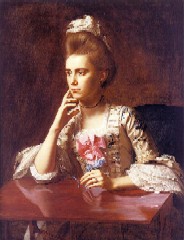This painting of Mrs. Richard Skinner (Dorothy Wendell) is done by John Singleton Copley in 1772. The mood is one of somber intrigue of an elegant woman who seems to be unaware of the artist’s presence. The informal view of her upper half is captured against a plain background of unidentifiable material, while the lower half is obscured by a table. Her light facial features and costume glean from a single, bright artificial light source. Copley’s artistic talents in the Boston area even without the proper tutelage in Europe are evident in this aesthetically pleasing painting. The flaws with respect to perspective and reflection images only slightly hinder the overall effect of the painting.
Firstly one would notice the rich color palette throughout the painting and the attention to detail in the woman’s face. The rich colors of the ornate flowers in reds, blues, and yellows on the creamy color of her dress juxtapose the transparent, airy pure white lace on the ends of her sleeves and the porcelain like complexion of her neck. The brown background, the brown mixed with the gray of her hair in the middle ground, and the shiny polished wooden table in the foreground encompass the woman. The spectrum of browns that flow throughout the painting unify and form a dark circle that accentuates the lighter palette of her face and costume. Her hazel brown eyes attract the viewer not only because of their consistency with the brown color scheme, but also because of there detail. The woman stares, unblinking, at the light source that reflects a single speck of white in her dark eyes as if she’s hypnotized by it. The focus of her gaze is intensified by the wide, low arches of her eyebrows in the look of deep concentration. Her painted lips and flawless complexion reveal no emotion, leaving only her somber eyes for the audience to determine her thoughts and the mood of the painting.
Copley’s use of chiaroscuro adds texture to the many facets of the painting, but his attempts at painting her reflection is somewhat doubtful. The elements of light and shadow as seen on her folds and creases of her ear and the white dot on her ruby earring are exquisite. As is the way the large pink bow falls because of its size; the physicality of the fabric is tangible. The chiaroscuro of the ruffles and stylistic accents of the dress give it its attractive contemporary form worn by aristocrats such as Mrs. Richard Skinner. The detail of the delicate blue flower petals appear soft and one can imagine their perfumed scent. The colors in the reflection on the table from the blue flower and her dress are hard to follow though. Underneath the sleeve of her arm there is an obscure shadow in the reflection that does not follow the line of her dress. The light along her hands and the corresponding shadows in every crease are very bright, clean lines. However, the reflection of her pinky and ring fingers on the hand holding the flower are not accurate in their anatomical shape; the reflection is bent more than the actual fingers. The length of the reflection does not seem to correspond with the length of her upward bent arm.
Also somewhat unrealistic in the composition of the painting is the depth perception from the front of the painting to the back. The depth and size of the table don’t seem appropriate to support the woman leaning against it. The narrow, thin size and shape seem miscalculated as it slopes into the foreground with spindly legs haphazardly placed underneath the top. The chair in the middle ground also lacks depth and stability. The dark blue chair is flat and stiff with out any shape or texture to the fabric. The actual size of the chair in reference to the woman seems small as her upper torso and bottom dress skirt cover most of it, but it’s hard to tell if she’s seated on the chair at all. The brush strokes in these blurry areas lack the fine detailed lines of the woman’s face and her garments, becoming broad and blended with the surrounding colors.
An interpretation of this painting must take into account the reasons for portraiture in American painting. Portraiture as a popular mode of the arts was displayed in a family home to be seen by the family, guests, and house servants as a symbol of the character’s status in society and place in family heritage. Mrs. Richard Skinner is a married woman, as evident by her wedding ring, and an aristocrat in Bostonian society by the elegance of her garments and carefully arranged hair. Not as a flaw, but a peculiarity of Copley’s painting as to portray Mrs. Richard Skinner, an aristocrat in this manner. Her body language is relaxed, leisurely positioned on the table, one hand against her cheek deep in thought. She looks at an unknown object or perhaps nothing at all instead of at the audience and yet they are still engaged in the painting. It seems odd that Copley captures this intense moment of intimacy for her portrait. She seems distracted as if lost in a nostalgic reverie or concerned about the future. One could guess from the flower she idly holds in her hand that she may be pregnant and contemplating this outcome. The intensity and mystery of her gaze allures the audience on an intellectual level giving the painting drama and romantic suspense. The beauty of the woman, her delicate form and simple features, and the poetic flower are in contrast to a feeling of dark foreshadowing.

